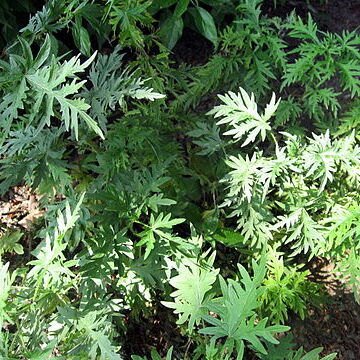Herbs perennial, monoecious. Rhizomes woody. Stems branched, 50-150 cm tall, sparsely hirtellous, sparsely armed with stinging hairs. Stipules free, linear, 5-15 mm, puberulent on both surfaces; petiole 2-8 cm, puberulent, with stinging hairs; leaf blade 5-angled in outline, 7-15 × 3.5-10 cm, abaxial surface puberulent and sparsely armed stinging hairs on veins, adaxial surface sparsely setulose, then glabrescent, margin 3-palmatisect or parmatipartite, primary lobes pinnatisect, gradually shortened distally, secondary lobes irregularly incised-serrate or shallowly serrate; cystoliths punctiform, densely adaxially. Inflorescences unisexual; male inflorescences in proximal axils, paniculate, 5-8 cm; female ones in distal axils, spicate, 2-7 cm, often erect, with a thick axis and few branches in proximal part. Male flowers short pedicellate or sessile, in bud 1.2-1.5 mm; perianth lobes connate 1/2 of length, ovate, puberulent. Female flowers: perianth lobes connate at basal 1/3, herbaceous, dorsal-ventral lobes elliptic-ovate, 2-4 mm, setulose and with 1-4 stinging hairs, lateral lobes ovate or oblong-ovate, 3-4 times as short as dorsal ones, often with single stinging hair. Achene gray-brownish, ovoid, slightly compressed, 2-3 mm, apex acute, verrucose, invested by persistent perianth lobes. Fl. Jul-Aug, fr. Aug-Oct.
More
A herb that grows in dense tufts. It keeps growing from year to year and has stinging hairs. It grows 1-2 m high. The stems have ridges. The leaves are oval an 4-13 cm long and wide. The leaves are divided like fingers on a hand. There are a few hairs on both surfaces. The flowers are greenish and of separate sexes on the same plant. They are in a group 12 cm long.
Slopes, roadsides and weed infested places. Thickets, grasslands, sand dunes, sandy beaches, river banks, roadsides, near villages, weed-infested places, 800-2800 m in N. China.
More
It is a temperate plant. In Inner Mongolia.

